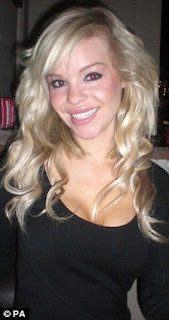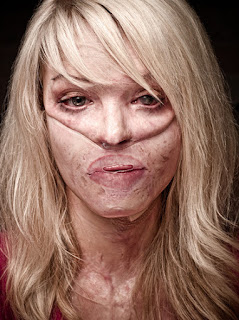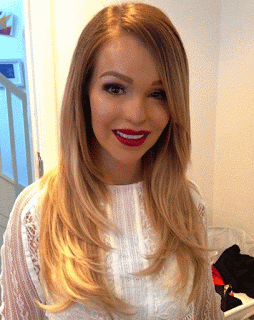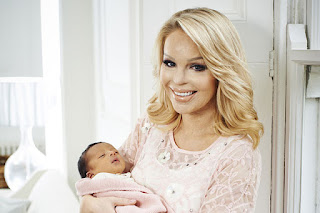Katie Piper is a television presenter and former model. At the age of 25, she was the victim of an acid attack. Piper was born in 1983 in Hampshire, aspiring to become part of the fashion world, looking up to her father, a barber. She became a beautician, then aimed to be a model. She took part in promotional, glamour and fashion photography shoots, and also starred in programmes such as 'Ashes to Ashes' as an extra. In 2006, she came the 2nd runner-up in Miss Winchester Beauty Pageant. Her career began to take off, she featured in international newspapers, and people were beginning to know her name.
 |
| Katie Piper, before the attack. |
In 2008, Piper was to be in 'Candy Crib', a reality television show, where models had to live in a house in an unknown location, each week being voted off by the public. A few months prior to this, Piper was contacted on social media by a man named Daniel Lynch, a martial arts expert, who she believed to have more substance than the men who usually tried to contact her. They arranged to meet at an event Katie was working at, where for the first time they met. Lynch seemed laid-back, and they agreed to keep in contact. After many messages being sent back and forth, he asked her on their first date, Katie suggesting London's Comedy Club. The date went well, with Daniel escorting Katie to the toilets during the interval, seeming chivalrous. They began to meet up more, when Daniel's text messages and emails started to become overwhelming for Katie. During one outing, Lynch lost his temper over a stall-holder calling Katie (darling), this is where Piper started to become concerned. When they weren't together, Lynch would send multiple messages to Katie, demanding to know where she was. One time, Katie counted 37 messages in a couple of hours. Her flatmates too became concerned, but Piper still continued the relationship, believing in him. In their second week of their relationship, Daniel wanted to buy both himself and Katie matching trainers, but when the assistant bought out a pair that seemed scuffed, Lynch went into meltdown, hurling abuse at the shop assistant. Katie now started to doubt that her new boyfriend was who he initially seemed to be. At the end of the day, Katie would tell him she didn't want to continue their relationship any longer.
That evening, Daniel and Katie decided to stay in a hotel for the night, as it would be closer to the hairdressers that Katie had an appointment for the next day. In the lift, Katie knew she was in trouble, as Lynch snarled 'You're not even all that in the flesh, are you?'. Once in the room, Katie was subjected to verbal abuse, then thrown across the room by Lynch. She hit her head on the door, and blood seeped out, but before she knew it she was falling in and out of consciousness. Lynch threw her on the bed, when he then raped her. After the ordeal, Katie rushed to the bathroom, where Lynch attacked her a second time, threatening her first with a disposable razor, then attaching a belt to the sealing and threatening to hang her. She managed to persuade him not to, and they both left the hotel together, Katie, too scared to run. He stopped at a mobile shop, as he had smashed Katie's in his rage, and bought her a new one so he could contact her. On dropping her home, he told her he would kill her and her family if anyone found out. Katie hurried back into the safety of her flat, where she told her flatmates and needed to be taken to hospital, although she was too scared Daniel would still be outside. He called her multiple times, shouting abuse and demanding to know where she was. She was treated at the hospital, and discharged the same day. She knew if she stayed in the flat she would be safe until she would be going into the Candy Crib, in a couple of days.
Two days after the initial attack in the hotel, Katie was called by Lynch, who told her to look at her email, as he explained all of his actions in it. Her internet was down, and Lynch suggested she go to a coffee shop down the road. She agreed, with Lynch calling to know her where abouts all of the time. Whilst on the phone to him, outside the coffee shop, Piper was approached by a hooded figure, a cup outstretched in his hands. She believed he was a homeless man, so reached into her bag to get some money, still on the phone to Lynch, when she was covered in liquid. She was confused as to what happened, when she felt the sharp burning slowly covering her body. Lynch stayed on the phone, listening to her screams. She ran into the coffee shop, desperate for help, throwing water on herself, and even flushing her face in the toilets. The customers quickly went to help, and sat her down, waiting for the ambulance to arrive, which took an hour. Katie lost consciousness, waking up thinking she was dead. In the hospital, Katie was questioned by the police who found the acid-thrower, Stefan Sylvestere, after he had splashed acid onto himself in the attack too. She was scared for her life, and told the police about Lynch. Katie suffered third degree burns all over her face, neck chest, and the acid had burned her oesophagus after she had accidentally swallowed some during the attack.
 |
| Katie Piper, during her recovery. |
Katie was put into an induced coma for 12 days. 40 operations were carried out to build the foundations for skin grafts, removing the dead and burned skin. She moved back to Hampshire, where her mother left her job at a school to care for her daughter. Katie had to wear a mask for 23 hours of the day, to flatten the scars and keep in the moisture. Katie has been left permanently disfigured, blind in one eye, and forced to eat through a feeding tube due to her oesophagus being burnt.
Katie gave up her anonymity in 2011, and told her story through Chanel 4's 'Cutting Edge' series, in an episode named 'Katie: My Beautiful Face'. This was shown to 3.5 million viewers, and was greatly received. Katie then founded 'The Katie Piper Foundation', a charity who aims to help fellow victims, and show the world that scars do not limit a person. This was supported by Simon Cowell, who is patron of the charity. Katie Piper's career has continued building, as she has created many TV shows focused on helping people. It is outstanding that throughout all of this, Katie is still a true philanthropist. She has written 3 books and an autobiography.
 |
| Katie Piper, after her recovery. |
She has since become engaged and had a baby daughter, Belle.
 |
| Katie Piper, with daughter Belle. |
Learning about Katie's life has further developed my research into acid burns. To learn about an individual's story like Katie's, educates you, and gives you an insight into their experience. By watching the documentaries that Katie has produced, and reading parts of her books and autobiography, put me in her shoes, you see her story in such more of an emotional view, compared to that of the media.
Channel 4’s Cutting Edge (2009) Katie Piper: My Beautiful Face. .
Piper, K. (2015) Beautiful Ever After. United Kingdom: Quercus Publishing.
Piper, K. (2011) Acid attack victim: I heard a horrible screaming sound... it was coming from me. Available at: http://www.dailymail.co.uk/femail/article-1351435/Acid-attack-victim-Katie-Piper-attacked-going-boy-met-Facebook.html (Accessed: 20 October 2015).

















































